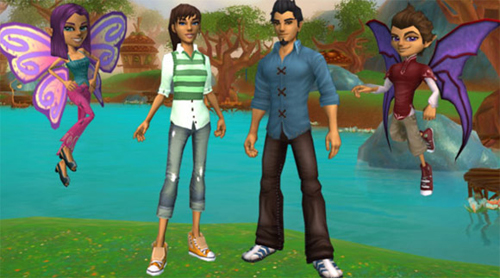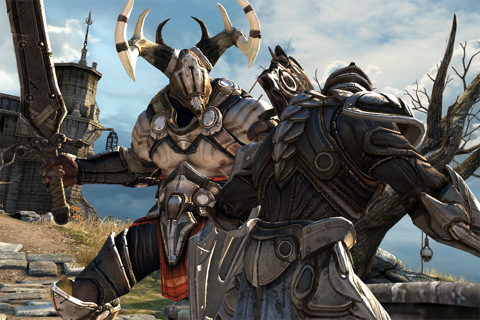业内话题:传统游戏领域如何应对免费运营模式挑战?
不久以前—-事实上也就是2005年,由于游戏生产成本提高,游戏产业认识到有必要提高掌机游戏的价格,并将其增至60美元。
但是今天—–仅仅过了6年,免费游戏就开始统治这一领域,游戏产业开始追问——固守付费运营模式的开发商和发行商将面临什么后果?
即使发行商们说他们的产品是高端游戏,但早已习惯只花一点儿钱或者一文不花的玩家还会乐意出这笔高价费用吗?
除此之外,由于iOS和Facebook平台的崛起,玩家已经越来越习惯通过iOS新渠道来获取游戏内容。新型运营和内容发行模式支持游戏公司迅速获得市场反馈,而微交易模式的兴起,也让游戏和工作室保持了生机和活力。
掌机游戏发行商和开发商究竟该如何应对这种情形?
市场咨询公司Fuzbi LLC的主管David Edery表示,“对于微软、索尼和任天堂来说,这种情况非常困难和复杂。他们很清楚如何行事,并将自身优势发挥到极致。这些公司以及它们的顶级游戏发行商很了解如何通过零售包装游戏大赚一笔,它们采用这种运营方式已经有些年头了。所以它们毫无疑问会害怕这种情形,生怕在这种转型中受挫。现在,它们已有一个自知可行的模式,但不知道其他模式是否奏效。因此,这就是它们为何迟迟没有推出应对策略的原因所在。”
他补充表示,“它们也很担心自己与零售商之间的合作关系,因为现在所有人都在说零售模式必亡,当然零售模式目前威力尚存。所以游戏开发商当然就会存在一堆这种想法,‘我们怎样才能在探索新模式的同时,避免惹恼GameStop和沃尔玛?’正是这种瞻前顾后的想法,让它们的业务转型变得更加棘手和复杂。”
事实也确实如此,在最近的媒体访谈中,任天堂坚称不会让现售40美元的3DS掌机游戏降价。
据DS项目主管Hideki Konno所称,“我们不会与1美元或者免费游戏大打价格战,我们只打算保持并提高产品质量,使其成功脱颖而出。再者,我们也不担心价格竞争,也不认为只有任天堂这么想,索尼和微软也极可能有相同看法。”
虽然索尼方面并没有发言人发表他们对免费游戏的看法,但从索尼在线娱乐(Sony Online Entertainment )不久前在PlayStation 3发布了那款流行的家庭免费游戏《Free Realms》一事就可以看出,答案已经不言而喻。
该游戏最初是在2009年登陆Windows平台(去年11月发布了Mac版本),目前已经吸引了近1.7亿注册用户。虽然玩这款游戏是免费的,但用户可以通过包月付费来获取额外内容,或者通过微交易购买游戏中的虚拟商品。
索尼在线娱乐曾在过去的媒体采访中表示,《Free Realms》将成为第一款免费的大型多人网游,也是所有掌机平台上的第一个以家庭用户为核心的虚拟游戏世界。
这或许可以理解为索尼正在为打入免费游戏领域探路,另外还有一些游戏发行商也正试水这个市场。
以美国艺电为例,这个游戏发行巨头正准备推出其第二款免费射击游戏《Battlefield Play4Free》,该游戏现在进入了公开测试阶段,有望在春季正式运营(游戏邦注:该公司的第一款免费游戏是2009年6月发布的《Battlefield Heroes》,第三款免费游戏将由其德国内部开发工作室EA Phenomic开发)。
该公司侧重于免费游戏项目的工作室Easy Studios总经理Ben Cousins表示,“我们已经在开发第三款采用免费运营模式的游戏了,这个市场现在充满大量极为年轻的玩家,对他们而言,冲进游戏店花60元美买下自己从未玩过的游戏,这种想法就像走进唱片店翻遍唱片一样,是非常不可思议的。”
“我不认为付费和免费这两种运营模式存在优劣差别。我只是觉得,今天的用户消费和体验游戏的行为已经发行变化,而这些新兴平台又提供了消费游戏的便捷途径。我认为发行渠道比运营模式更重要。”
具备两年免费游戏开发经验的Cousins表示,他在这期间经历了两个重大的观念转变,其中之一就是发布新游戏时,这个过程还没有结束,而只是刚刚开始。据他所述,“开发者需要高度依赖用户反馈参数等市场数据。如果只是根据道听途说的传言和自己的感觉来判断游戏的优劣,那可能就会做出错误决策,从而将产品扼杀在摇篮里。我们已经学会观察市场数据,以这些参数指导项目运营,而不是完全凭创意运营项目。”
虽然Cousins认为未来难料,但他相信付费运营模式会像包装类的零销音乐产品一样走向末路。
“EA是能够与进俱进地采用新型经营模式的公司之一,我认为只有这类大胆地追求新型经营模式的公司才有可能幸存下来,那些只盯着短期回报而不考虑转变的公司,可能将会陷入困境。”
但Chair Entertainment公司(游戏邦注:其母公司是Epic Games)的联合创始人及创意总监Donald Mustard却认为,付费与免费是并行不悖的两种运营模式。
他在Xbox Live Arcade平台上发布了《Shadow Complex》,并推出了iOS版本的《Infinity Blade》,可以说他对这两种运营模式都有发言权。
他的观点是,“作为一个用户,我希望自己的iPhone上安装的是超短时间、即时体验的游戏,但同时又能在伴着环绕立体声的大电视屏幕上玩又贵又华丽的大型游戏,这两种体验我都想要——我认为有不少人的想法和我一样。我相信在游戏界里总有一些聪明人,知道通过改变他们的产品来满足用户需求。”
事实上,Chair Entertainment团队的策略准确地来说是这样的——关注各种平台并且分析各个平台的机遇所在。
举个例子,当Chair Entertainment决定成为新兴的iOS市场的一部分时,它很认真地考虑了什么样的游戏才能够成功,以及人们对这些游戏的玩法。
“因为iPhone具有触摸屏,而Xbox 360却没有这种情况,我们想利用触摸屏这一功能为玩家带来不同的游戏体验,但这种体验在Xbox 360或PS3可能无法实现,我们正是根据iPhone的硬件特点来设计《Infinity Blade》,所以这是一款与掌机游戏完全不同的产品,这种不同体现在玩家的触摸体验,游戏时长等各个方面。”
“我们在《Shadow Complex》采用了相同的策略——分析了在Xbox 360特殊的控制器上,我们能搞点什么特别的设计,并认为这就是我们成功的原因——找到不同设备的优势和发展潜力,并根据它们的特点,量体裁衣地开发游戏。”
Mustard回想起发布《Infinity Blade》的时候,玩家的反应之快令人惊叹。用户的这种即时反馈有助于开发商依此完善游戏,而掌机游戏领域却根本不可能具有这种优势。
“例如,我们发布游戏后立即就收到一些iPad用户的反馈,他们希望能把躲避按钮做得大一点,因为他们的手指很难触摸到这些键,而从前遇到这种情况时,我们通常都会说,总有那么一小撮人会抱怨,这还不值得我们花时间去打补丁。但因为这款游戏发布于iOS平台,所以我们就会说,‘真是个好主意!’我们几天之内就推出了让玩家把按钮放大或缩小的选项。这种可迅速对市场作出反应的经历真是让我们受益匪浅。”
Chair希望创造出新一代横向卷轴的游戏,这类游戏能够充分发挥Xbox 360平台的优势,“我们不认为这类游戏能卖60美元,但觉得这类游戏还是会很有市场,我们非常高兴微软提供了一个数码游戏市场——Xbox Live Arcade,我们在这个平台上可以把《Shadow Complex》标价为15美元或者20美元。最起码,我们找到了两个不同的游戏平台,两个平台都能接纳这些特别的游戏,并在两个平台大获成功。”
Mustard称掌机游戏领域仍将“不可避免”地向iOS领域取经——尤其是快速升级和应对用户反馈这两个方面。“我认为发生在社交游戏和手机游戏领域的情况,将彻底改变掌机游戏的进步方式。”
真正的问题是,两三年后下一代游戏机露面时,它的市场反应会如何?Ben Cousins认为到那时,玩家的iPad或者手提电脑会比掌机设备更强大。
他的看法是,“我们可能会发现,到2012年或2013年,那时的免费游戏不仅免费,而且事实上我们玩免费游戏甚至还比体验掌机游戏更方便——这些游戏质量看起来还会更好,如果现在我是一个掌机设备制造商,我认为iPad会成为最让我头疼的东西。”
Fuzbi公司的Edery看法与此相同,“在不远的将来,任天堂可能一觉醒来就发现,苹果动了他们的奶酪,或者谷歌Android分食他们的蛋糕。如果掌机游戏开发商不立即开始转变——这些不及时,结果现在已不复当初的光芒。毫无疑问,掌机游戏开发商如果不引以为诫,也终会步入柯达的后尘。”(本文为游戏邦/gamerboom.com编译,转载请注明来源:游戏邦)
The Necessity Of Making Free-to-Play Moves
Seems not that long ago — in 2005, in fact — that the industry felt the need to boost console game prices — to as much as $60 — in light of the rising cost of current-gen production.
But today — only six years later — in a very different world where “free-to-play” reigns, the industry is wondering aloud what will become of developers and publishers who stubbornly refuse to leave the paid business model behind.
Will gamers who are becoming used to getting their gaming fix at a nominal cost — or at no cost whatsoever — be willing to pay premium prices… even if publishers can make the case that theirs are premium games?
Beyond pricing, gamers have become increasingly used to new ways to consume content, thanks in large part to iOS and Facebook. New business and content models allow for agile responses to users’ requests and microtransaction updates keep games lively — and studios alive.
How important is it for console publishers and developers to respond to all this?
“This is very difficult and very complicated for Microsoft and Sony and Nintendo,” says David Edery, principal of consulting firm Fuzbi LLC. “They know how to do one thing and do it very well. They — and their top publishers — know how to sell you a retail product for a large amount of money… and they’ve been doing that for a long time.
“So there’s no question that they’re scared; they’re scared of screwing up a transition. Right now they have a model that they know works and they don’t know if other models will work for them. And, consequently, that’s why you see them moving so damned slowly.
“They’re also worried about their relationship with retailers,” he adds. “You hear everyone talking about the inevitable death of retail, but retail isn’t dead yet; it still does have power. So the console makers have certainly been giving a lot of thought to ‘How the heck do we explore these new models while, at the same time, not pissing off GameStop and Walmart too much.’ And that makes this whole transition exponentially more complicated than it might be otherwise.”
Indeed, in a recent Gamasutra interview, Nintendo insisted that it won’t be cutting the prices of its 3DS handheld games, which currently sell for about $40 each.
“In terms of one dollar games or free games… we’re not going to be competing with that,” said 3DS project lead Hideki Konno. “We’re just going to continually strive to not just maintain, but increase, the quality of the entertainment that we’re providing, and let it sort itself out. Again, we’re not worried about competing at a price point level. And I don’t think that’s just Nintendo; I believe that’s more than likely Sony and Microsoft’s opinion on that as well.”
But while Sony would not provide a spokesperson to discuss its take on free-to-play games, the fact that two weeks ago its Sony Online Entertainment division released its popular and family-friendly free-to-play game Free Realms on the PlayStation 3 speaks for itself.
Originally launched for Windows in 2009 (a Mac edition debuted last November), Free Realms has picked up almost 17 million registered users. Though playing the game is free, users can purchase monthly memberships for additional content as well as in-game items via microtransactions.
In a story on Gamasutra last month, SOE was quoted as saying that Free Realms will be the first free-to-play MMO and the first family-targeted virtual world released on any console.
This could be a testing ground for future forays by Sony into the world of free-to-play, just as other publishers are dipping in their toes to test the waters.
At Electronic Arts, for instance, the giant publisher is poised to come out with its second free-to-play shooter, Battlefield Play4Free, which is currently moving into open beta and which is expected to fully launch during the spring. Its first, Battlefield Heroes was released in June 2009. And one of EA’s other internal development studios — EA Phenomic in Germany — is about to start development on its third free-to-play title.
“So we’re already in our third generation of titles in this business model which is a consumer behavior-led thing,” says Ben Cousins, who until recently had been general manager of the publisher’s free-focused Easy Studios. “There’s a whole generation of very young people out there for whom the idea of going to a game store and spending $60 on something they haven’t even tried yet is a very strange thing, just as it would their going to a record store and rifling through the vinyl.”
“I don’t think either business model — paid or free — is better than the other. I just think we’re looking at a change of behaviors in consumers and these new
platforms allow a very convenience-driven consumption of games. I think of it this way — rather than the business model coming first, it’s the distribution method that came first.”
With two years of free-to-play under his belt, Cousins says one of the two biggest mental shifts he’s had to undergo is that, when you launch the game, the process isn’t finished; it’s just starting.
And, he says, you need to be “incredibly, deeply reliant on metrics and data. If you rely on hearsay or your feelings about the product, you can kill it by making wrong decisions. We’ve learned to watch our metrics and become a data-driven business rather than a completely creatively-driven business.”
While Cousins says it’s hard to predict the future, he believes there’s a good chance that the paid business model will completely collapse in the same way the
packaged goods music model has collapsed.
“Companies that are able to move with the times and adopt the new business models — and EA is an example of one which I think is very aggressively pursuing new business models — they’re likely to survive,” he adds. “Companies that are just looking at short-term returns and aren’t thinking about this inflection point, I think those companies could find themselves in trouble.”
But Donald Mustard believes there’s room enough for everybody.
Mustard is creative director and co-founder of Chair Entertainment Group, whose parent is Epic Games. Having developed Shadow Complex for Xbox Live Arcade and Infinity Blade for iOS, he has experience in both arenas.
“As a consumer, I want to be able to have super-short-session games on my iPhone and I want to have huge, expansive, amazing experiences on my big TV with my surround sound,” he explains. “I want all of it. It gives me a ton of diversity as a gamer — and I think there are lots of people out there who feel the same way. I believe there are some really smart people in the games industry who understand this and will shift what they produce to accommodate the consumers.”
In fact, Mustard’s strategy at Chair Entertainment has been exactly that — looking at the various platforms and analyzing where the opportunities lie in each.
For instance, he says, when Chair decided that it wanted to be part of the emerging iOS market, it took a careful look at what games were successful and how people were playing those games.
“Because the iPhone has a touchscreen and the Xbox 360 doesn’t, we wanted to utilize that touchscreen in a way that was unique that would provide a different type of gaming experience than one might have on an Xbox 360 or PS3,” he recalls. “And we designed Infinity Blade from the ground up to utilize all the iPhone features so that the game would be totally different — in the way you touch it, in how long you play it, and so on.
“We took the same approach on Shadow Complex — analyzing what we could do that was unique to the Xbox 360, to its specific controller. And we think that’s what has led to a lot of our success… finding the strengths and the opportunities of different devices and tailoring experiences for it.”
Mustard recalls being amazed at how quickly gamers responded when Infinity Blade was released, showering Chair with instantaneous feedback that enabled the developer to improve the game in a way that would have been impossible with a console game.
“For example, we immediately heard from just a few people who were playing on their iPads and wished we had made the dodge buttons a little bigger because their fingers had a hard time reaching them,” he says. “Traditionally we would have said that there was such a small number of people with that complaint that it wasn’t worth the time and effort to create a patch.
“But, with the iOS platform, we were like ‘Hey, that’s a good idea!’ — and within a few days we had given gamers the option to make that button larger or smaller.
That was an eye-opening experience for us — to be able to respond to the market that quickly.”
Similarly, Chair wanted to create a next-gen modern side-scroller that utilized the power of the Xbox 360. “We didn’t think we could sell that kind of game for $60, but we still thought there was a market for it,” Mustard recalls.
“We were so glad that Microsoft has a digital market — Xbox Live Arcade — where we could sell Shadow Complex for $15 or $20. And so the bottom line was that we found two different platforms for our two games, both very appropriate to those particular games, and both turned out to be hugely successful.”
All the same, Mustard said that it is “inevitable” that the console space will have to learn from the iOS space — when it comes to quick updates and responsiveness to users. “I think that the things that are happening in the social space and the handheld space are going to completely change the way we look at console games moving forward,” he told Gamasutra in a recent interview.
The real question is what will the market be like when the next generation of consoles is unveiled two to three years from now. Ben Cousins believes that, by that time, gamers’ iPads or their laptops will be significantly more powerful than consoles.
“So we could find ourselves at a point in 2012 or 2013 where a free-to-play game is not only free but is actually more convenient to play than a console game — and even looks better,” he says. “If I were a console maker today, I think the iPad would be my biggest worry.”
Fuzbi’s Edery agrees.
“In the very near future, it’s very possible that Nintendo could wake up and find that Apple has eaten their lunch — or Google through Android has done it. If the console makers don’t start the transition process immediately, well, history is littered with companies that waited too long to embrace a revolution that was threatening their core business,” he says.
“I mean, Kodak is the classic example. Digital photography was trying to take off and Kodak had this incredibly lucrative film business — so they hemmed and hawed about whether it was worth tackling. The next thing you know it, Kodak is a shadow of its former self. That’s exactly what can happen to console makers, there’s just no question about it.”(source:gamasutra)









































 闽公网安备35020302001549号
闽公网安备35020302001549号